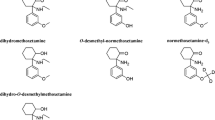Abstract
Animal models, consistent with the hypothesis of direct interaction of paraquat (PQ) and 1-methyl-4-phenyl-1,2,3,6-tetrahydropyridine (MPTP) with specific areas of the central nervous system have been developed to study Parkinson’s disease (PD) in mice. These models have necessitated the creation of an analytical method for unambiguous identification and quantitation of PQ and structurally similar MPTP and 1-methyl-4-phenylpyridinium ion (MPP+) in brain tissue. A method for determination of these compounds was developed using microwave-assisted solvent extraction (MASE) and liquid chromatography–mass spectrometry. Extraction solvent and microwave conditions such as power and time were optimized to produce recoveries of 90% for PQ 78% for MPTP and 97% for its metabolite MPP+. The chromatographic separation was performed on a C8, column and detection was carried out using an ion trap as an analyzer with electrospray ionization. Mass spectrometer parameters such as heated capillary temperature, spray voltage, capillary voltage and others were also optimized for each analyte. Analysis was done in selective ion-monitoring (SIM) mode using m/z 186 for PQ, m/z 174 for MPTP, and m/z 170 for MPP+. The method detection limit for paraquat in matrix was 100 pg, 40 pg for MPTP, and 20 pg MPP+.




Similar content being viewed by others
References
Haley T (1979) Clin Toxicol 14:1–461
Liou HH, Tsai MC, Chen CJ, Jeng JS, Chang YC, Chen SY et al (1997) Neurology 48:1583–1588
Thiruchelvam M, Brockel BJ, Richfield EK, Baggs RB, Cory-Slechta DA (2000) Brain Res 873:225–234
Dinis-Oliveira RJ, Remião F, Carmo H, Duarte JA, Sánchez Navarro A, Bastos ML, Carvalho F (2006) NeuroToxicology 27:1110–1122
R Betarbet, TB Sherer, G MacKenzie, M Garcia-Osuna, AV Panov & JT Greenamyre (2000) Nat Neurosci 3:1301-1306
Gorell JM MD, Johnson CC PhD, Rybicki BA PhD, Peterson EL PhD, Richardson RJ ScD (1998) Neurology 50:1346-1350
Meredith GE, Halliday GM, Totterdell S (2004) Parkinsonism & Related Disorders 10:191–202
Thiruchelvam M, Cory-Slechta D (2002) NeuroToxicology 23:621–633
Perry JC, Da Cunha C, Anselmo-Franci J, Andreatini R, Miyoshi E, Tufik S et al (2004) Eur J Pharmacol 484:225–233
Cicchetti F, Lapointe N, Roberge-Tremblay A, Saint-Pierre M, Jimenez L, Ficke BW, Gross RE (2005) Neurobiol Dis 20:360–371
Kuter K, Smialowska M, Wieronska J, Zieba B, Wardas J, Pietraszek M, Nowak P, Biedka I, Roczniak W, Konieczny J, Wolfarth S, Ossowska K (2007) Brain Res 1155:196–207
McCormack AL, Thiruchelvam M, Manning-Bog AB, Thiffault C, Langston JW, Cory-Slechta DA, Di Monte DA (2002) Neurobiol Dis 10:119–127
Corasaniti MT (1990) J Chromatogr 527:189–195
Castro R, Moyano E, Galceran MT (2001) J Chromatogr A 914:111–121
Mutavdžić D, Babić S, Horvat AJM, Kaštelan-Macan M (2007) Trends Anal Chem 26:1062–1075
Kaufmann B, Christen P (2002) Phytochem Anal 13:105–113
Kavita Prasad, Elizabeth Tarasewicz, Jason Mathew, Pamela A. Ohman Strickland, Brian Buckley, Jason R. Richardson and Eric K. Richfield (2009) Exp Neurol 215:358-367
Prasad K, Winnik B, Thiruchelvam M, Buckley B, Mirochnitchenko O, Ritchfield E (2007) Environ Health Perspect 115:1448–1453
Ralph D. Whitehead, Jr.1, M. Angela Montesano1, Nayana K. Jayatilaka1, Brian Buckley, Bozena Winnik, Larry L. Needham, and Dana B. Barr, Method for measurement of the quaternary amine compounds paraquat and diquat in human urine using high-performance liquid chromatography-tandem mass spectrometry, (2009) J. Chrom. B. in press
Strelevitz TJ, Linhares MC (1996) J Chromatogr B 675:243–250
Doerge DR, Fogle CM, Paile MG, McCullagh M, Bajic S (2000) Rapid Commun Mass Spectrom 14:619–623
Sarah M.R. Wille, Kristof E. Maudens, Carlos H. Van Peteghem, Willy E.E. Lamber (2005) J Chromatogr A 1098:19-29
Shinozuka T, Terada M, Tanaka E (2006) Forensic Sci Int 162:108–112
Acknowledgement
This work was supported by NIH grant ES005022.
Author information
Authors and Affiliations
Corresponding author
Rights and permissions
About this article
Cite this article
Winnik, B., Barr, D.B., Thiruchelvam, M. et al. Quantification of Paraquat, MPTP, and MPP+ in brain tissue using microwave-assisted solvent extraction (MASE) and high-performance liquid chromatography–mass spectrometry. Anal Bioanal Chem 395, 195–201 (2009). https://doi.org/10.1007/s00216-009-2929-z
Received:
Revised:
Accepted:
Published:
Issue Date:
DOI: https://doi.org/10.1007/s00216-009-2929-z




